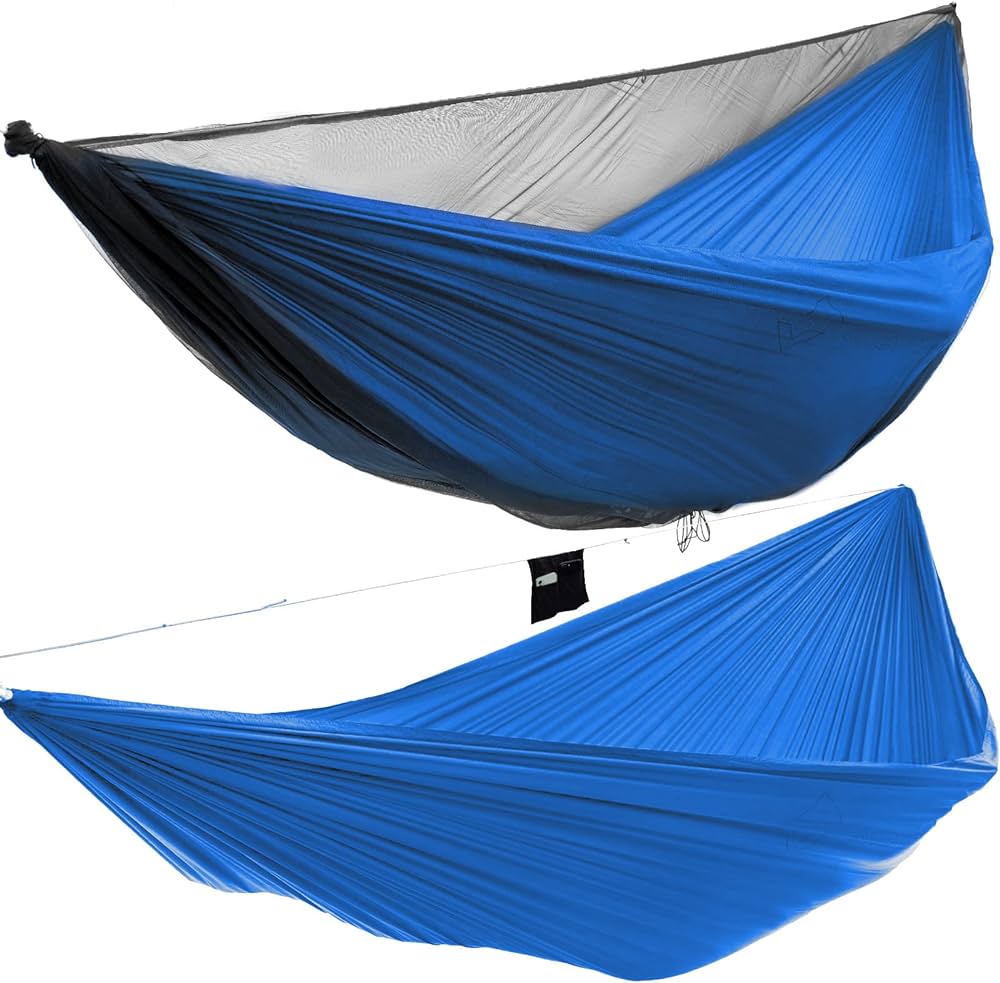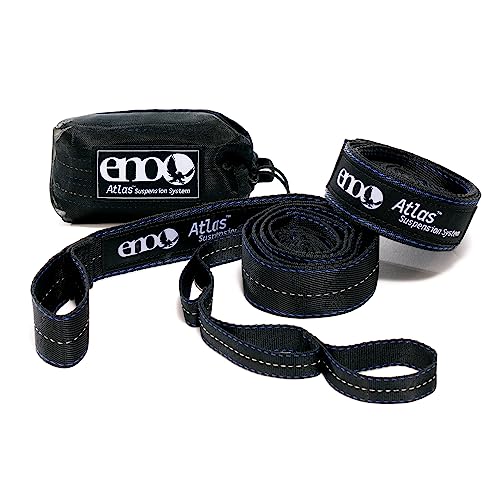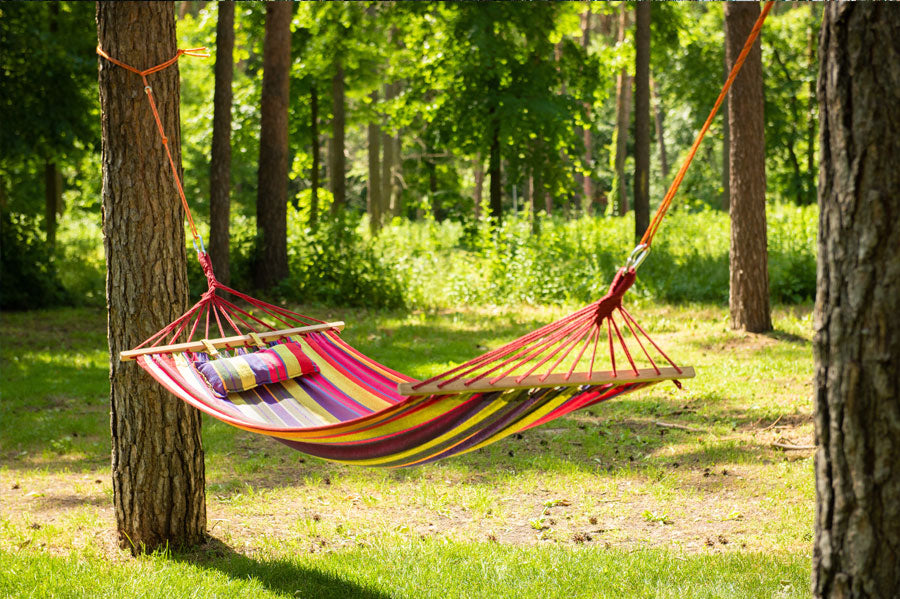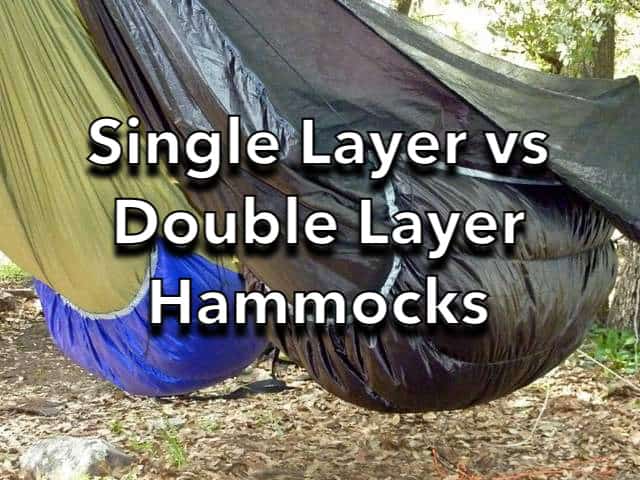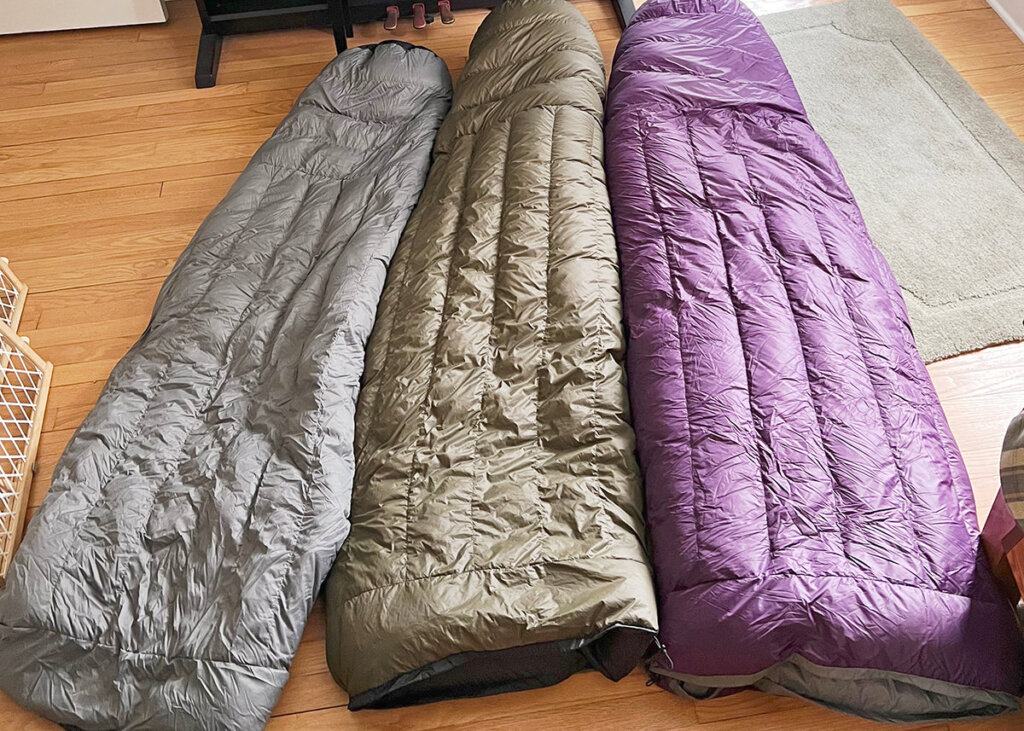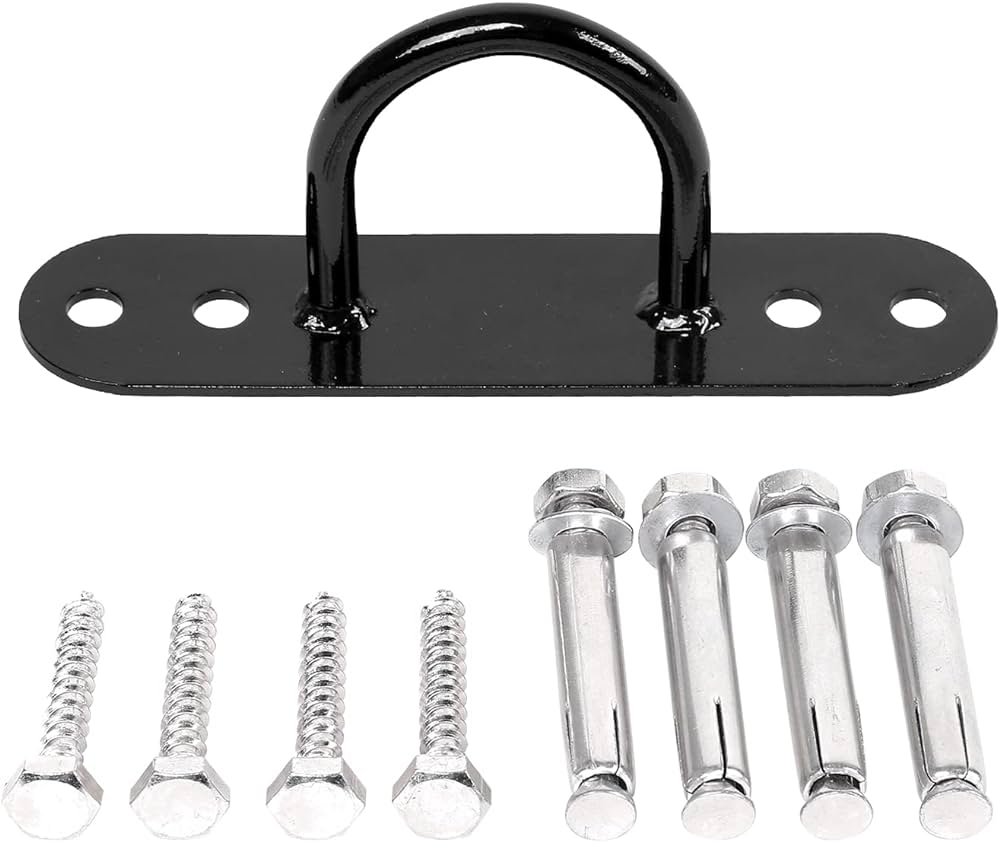- 8 Airplane Footrest Hammock!Travel comfortably - October 9, 2023
- top 7 Pool Float Water Hammock for a Relaxing Summer - October 9, 2023
- top 5 Space SaverSingle Hammock Stand Maximize Comfort and Space - October 9, 2023
Yes, a hammock needs a ridgeline to maintain the right sag and hang, even when the straps are pulled further apart. A ridgeline helps keep the hammock at the desired angle and distance between attachment points.
Setting up a hammock and achieving the perfect hang can sometimes be a challenging task. There are situations where the distance between the trees or attachment points might be further apart than desired, affecting the hang and sag of the hammock.
That’s where a ridgeline comes in handy. In simple terms, a ridgeline is a length of cordage that attaches to each end of the hammock and helps maintain the optimal sag, regardless of the distance between the attachment points. This structural element ensures a comfortable laying experience and relieves the stress and pressure on the hammock caused by different angles and distances. We will explore the importance and benefits of using a ridgeline for your hammock setup.
The Importance Of A Ridgeline In Hammock Setup
When it comes to setting up a hammock, many people overlook the importance of a ridgeline. However, a ridgeline plays a crucial role in maintaining the proper hang and sag of a hammock. In this article, we will explore what a ridgeline is, how it affects hammock setup, and its role in maintaining the proper hang and sag of a hammock.
What Is A Ridgeline?
A ridgeline, also known as a structural hammock ridgeline, is a cord or line that attaches to each end of a hammock. It runs above the hammock, parallel to the ground, and provides support and stability. The ridgeline is typically made from high-strength cordage and can be either fixed or adjustable in length.
How Does A Ridgeline Affect Hammock Setup?
The ridgeline plays a crucial role in hammock setup by helping to maintain the proper hang and sag. When you set up a hammock, the ridgeline allows you to achieve the desired amount of sag, regardless of the distance between the attachment points. Without a ridgeline, it can be challenging to achieve the optimal hang, leading to discomfort and a less enjoyable hammock experience.
By using a ridgeline, you can ensure that your hammock has the correct amount of sag, allowing for a comfortable and supportive sleep or relaxation position. Whether the trees are close together or further apart, the ridgeline helps maintain the desired sag, providing a consistent and comfortable sleeping or lounging experience.
The Role Of A Ridgeline In Maintaining The Proper Hang And Sag Of A Hammock
The primary role of a ridgeline is to help maintain the proper hang and sag of a hammock. The ridgeline provides support and stability, ensuring that the hammock stays level and properly supports your body weight. It also helps prevent the hammock from being too taut or too loose, which can lead to discomfort and an unstable sleeping or lounging surface.
Additionally, the ridgeline assists in achieving the recommended 30-degree hang angle for optimal comfort and support. This angle allows for a slight layback position, which helps reduce pressure points and promotes a more restful sleep. The ridgeline ensures that the hammock maintains this angle, even in different hanging configurations or distances between attachment points.
In conclusion, a ridgeline is a critical component of hammock setup. It helps maintain the proper hang and sag, allowing for a comfortable and supportive sleeping or lounging experience. Whether you are a camping enthusiast or simply enjoy relaxing in a hammock in your backyard, a ridgeline is an essential tool that shouldn’t be overlooked.
Understanding The Mechanics Of A Ridgeline
The Length Of A Ridgeline
A hammock ridgeline is a cord that runs above the hammock, connecting both ends. Understanding the mechanics of a ridgeline starts with knowing its length. The length of a ridgeline varies depending on personal preference and hammock setup. Typically, a ridgeline measures approximately 83% to 85% of the total length of the hammock. However, some hammock enthusiasts may choose a longer or shorter ridgeline based on factors like comfort, desired sag, and specific camping conditions.
The Impact Of Ridgeline Length On Hammock Setup
The length of the ridgeline plays a crucial role in achieving the perfect hammock setup. A longer ridgeline creates more tension, resulting in a flatter hammock lay. This is beneficial for those who prefer a firmer and more stable sleeping surface. On the other hand, a shorter ridgeline allows for a deeper sag in the hammock, providing a more relaxed and enveloping experience.
It’s important to note that the impact of ridgeline length goes beyond comfort. A longer ridgeline can also affect the angle at which the hammock hangs from the suspension straps. This can be advantageous in situations where trees are farther apart or when dealing with challenging terrain. Conversely, a shorter ridgeline may be preferred when hanging in tighter spaces or when a higher degree of flexibility is desired.
Exploring Different Materials For Ridgelines
When it comes to choosing the right material for a ridgeline, there are several options available. Paracord and utility cord are popular choices thanks to their strength and versatility. Paracord, known for its high tensile strength, is a lightweight and durable option that can withstand heavy loads. It’s important to choose a paracord with a minimum breaking strength of 550 pounds to ensure reliable support.
Utility cord, also known as guyline cord or accessory cord, is another viable option for a ridgeline. With its flexibility and weather resistance, utility cord provides good support and is suitable for various camping conditions.
When selecting a ridgeline material, consider factors such as weight, durability, and ease of use. It’s essential to choose a reliable cordage that can withstand the stress and tension placed upon it. Additionally, be sure to learn and practice proper knot tying techniques to ensure the ridgeline remains secure throughout your hammock camping adventures.
Comparing Adjustable Ridgelines Vs. Fixed Ridgelines
When it comes to hammock camping, the use of a ridgeline can greatly enhance your experience by providing a consistent and comfortable hang. A ridgeline is a cord or strap that runs above the hammock, connecting the two anchor points and creating a stable reference line. This line helps to achieve the ideal amount of sag and ensures a proper hang every time you set up your hammock.
Why Choose An Adjustable Hammock Ridgeline?
An adjustable hammock ridgeline offers the flexibility to customize your hang according to your preferences. With adjustable ridgelines, you can easily modify the length of the line, allowing for easy adjustments to the amount of sag in your hammock. Whether you prefer a deep sag or a tight hang, an adjustable ridgeline gives you the freedom to fine-tune your setup to achieve optimal comfort.
Benefits And Drawbacks Of Adjustable Ridgelines
Adjustable ridgelines come with their own set of advantages and disadvantages. Let’s take a closer look:
| Benefits | Drawbacks |
|---|---|
|
|
Fixed Ridgelines: When Are They More Suitable?
While adjustable ridgelines offer flexibility, there are situations where fixed ridgelines may be more suitable:
- If you have found your preferred hammock sag and want a consistent hang each time you set up
- When you prefer simplicity and ease of setup without the need for adjustments
- In scenarios where weight reduction is a priority, as fixed ridgelines tend to be lighter
Fixed ridgelines provide a reliable and consistent hang, eliminating the need for adjustments and allowing for quick and hassle-free setup. They are particularly beneficial for hammock campers who have already dialed in their preferred hang and seek a consistent experience every time.
Exploring Different Types Of Ridgelines
When it comes to hammock camping, one of the key considerations is the use of a ridgeline. A ridgeline is a cord that runs above the hammock, connecting the two anchor points, and it serves several important purposes. Firstly, it provides structural support to the hammock, ensuring a comfortable and secure hang. Secondly, it helps maintain the proper sag and tension of the hammock, regardless of the distance between the trees or anchor points. While a hammock can be set up without a ridgeline, having one offers numerous benefits that can greatly enhance the hammocking experience.
Continuous Vs. Split Ridgelines: Pros And Cons
One of the first decisions to make when considering a ridgeline for your hammock is whether to opt for a continuous or a split ridgeline. Each type has its pros and cons, and understanding these can help you make an informed decision.
Continuous Ridgeline
A continuous ridgeline is a single, unbroken cord that runs above the hammock from one anchor point to the other. It offers several advantages:
- A continuous ridgeline is easy to set up and adjust, allowing for quick and precise tensioning of the hammock.
- It provides a consistent and even sag throughout the entire length of the hammock.
- The continuous ridgeline can also be used to hang gear and accessories, such as a tarp or mosquito net, keeping them within easy reach.
However, a continuous ridgeline may have some drawbacks:
- It requires a longer length of cord, which adds to the weight and bulk of your gear.
- On uneven terrain, the continuous ridgeline may be more challenging to set up and adjust properly.
Split Ridgeline
A split ridgeline consists of two separate cords that connect to the hammock at each anchor point. Here are some advantages of a split ridgeline:
- The split ridgeline allows for independent tensioning of each side of the hammock, providing more control over the sag and tension.
- It can be easier to set up and adjust on uneven terrain, as each side can be adjusted separately.
However, there are a few considerations to keep in mind when using a split ridgeline:
- The two separate cords may require additional hardware, such as carabiners or toggles, to connect to the hammock.
- There may be a slight variation in the sag between the two sides of the hammock, which can affect comfort.
Example Of Adjustable Hammock Ridgelines
If you’re looking for even more flexibility and versatility, you may consider an adjustable hammock ridgeline. This type of ridgeline allows you to easily change the length and tension of the cord, providing precise control over the hang of your hammock. Adjustable ridgelines often use innovative systems like whoopie slings or knots like the Hennessey knot to make adjustments effortless.
Benefits of an adjustable hammock ridgeline include:
- Quick and easy adjustments, allowing you to fine-tune the hammock’s sag and tension according to your preference.
- Greater versatility in various camping environments, as you can adapt the ridgeline to different distances between anchor points.
- The ability to switch between different hammocks or adjust the hang based on changing weather conditions.
However, keep in mind that adjustable ridgelines may require more knowledge and practice to set up and adjust correctly. It’s essential to learn the specific techniques and knots associated with the adjustable system you choose to ensure a safe and secure hammock setup.
Understanding The Purpose And Benefits Of A Ridgeline
htmlHow A Ridgeline Helps Maintain The Optimal Hang And Sag Of A Hammock
When it comes to hanging a hammock, achieving the perfect hang and sag can be a challenge, especially when the trees are further apart than desired. This is where a ridgeline comes into play. A ridgeline is a high-strength cordage that attaches to each end of your hammock, helping to maintain the optimal hang and sag regardless of the distance between the attachment points.
A ridgeline ensures that your hammock remains at the ideal sag no matter how far the straps are pulled out. This is crucial for achieving maximum comfort while lounging or sleeping in your hammock. Without a ridgeline, your hammock may end up too tight or too loose, resulting in an uncomfortable and unstable setup.
Ensuring Comfort And Proper Body Position With A Ridgeline
One of the key benefits of a ridgeline is that it helps ensure comfort and proper body position while using a hammock. By maintaining a consistent level of sag, a ridgeline provides the necessary support for your body weight. This helps alleviate pressure points and prevents the hammock fabric from wrapping tightly around your body.
By using a ridgeline, you can achieve the optimal amount of sag for your hammock, allowing your body to lie in a natural and ergonomic position. This promotes better alignment of the spine and reduces strain on your back and neck, resulting in a more restful and rejuvenating hammocking experience.
Enhancing Stability And Reducing Sway With A Ridgeline
In addition to maintaining the optimal hang and sag, a ridgeline also enhances the stability of your hammock setup. By providing a fixed reference point, the ridgeline minimizes the sway and swinging motion often experienced in hammocks. This is especially beneficial for those who are sensitive to motion or easily disturbed by swaying movements.
A ridgeline acts as a stabilizer by distributing the tension evenly across the hammock, preventing excessive movement and maintaining a more controlled and stable environment. This allows you to relax and enjoy your hammock without the constant swaying that can disrupt your comfort and relaxation.
Overall, a ridgeline is an essential accessory for any hammock enthusiast. It not only helps maintain the optimal hang and sag, ensuring maximum comfort, but also provides stability and reduces unwanted sway. Whether you are a casual hammocker or a dedicated outdoor enthusiast, incorporating a ridgeline into your hammock setup will greatly enhance your hammocking experience.

Credit: bonfire.campanyon.com
Frequently Asked Questions On Does A Hammock Need A Ridgeline
Does A Hammock Need A Ridge Line?
Yes, a hammock needs a ridgeline to maintain the proper sag and angle, especially when the trees are further apart. A ridgeline helps keep the hammock at the right sag, regardless of the distance between attachment points.
What Is The Purpose Of The Ridgeline On A Hammock?
A ridgeline on a hammock helps maintain the right sag and comfort, regardless of the distance between attachment points. It ensures the hammock stays at the desired angle and provides support for optimal relaxation.
What Percentage Of Hammock Is Ridgeline?
The percentage of hammock that is a ridgeline varies depending on the setup and personal preference. A ridgeline helps maintain the right sag and hang angle regardless of the distance between attachment points. It ensures a comfortable laying experience.
Do You Need A Ridgeline For A Tarp?
Yes, you need a ridgeline for a tarp. A ridgeline helps to keep your hammock at the right sag, regardless of the distance between attachment points. It ensures a comfortable laying experience and helps center the tarp over the hammock.
Why Should I Use A Ridgeline With My Hammock?
Using a ridgeline with your hammock helps ensure the right amount of sag, regardless of the distance between the attachment points. This results in a more comfortable laying experience.
How Does A Ridgeline Keep My Hammock At The Right Sag?
A structural hammock ridgeline is made from strong cordage and attaches to each end of your hammock. It helps dial in the correct amount of sag for optimal comfort, even when the trees are further apart.
Conclusion
A ridgeline is not essential for a hammock, but it can greatly enhance your hammock setup. It helps maintain the right sag and angle, regardless of the distance between attachment points. By using a ridgeline, you can achieve a comfortable and consistent hang every time.
So, while a ridgeline may not be necessary, it can significantly improve your hammock experience. Consider adding one to your setup for better comfort and versatility.

